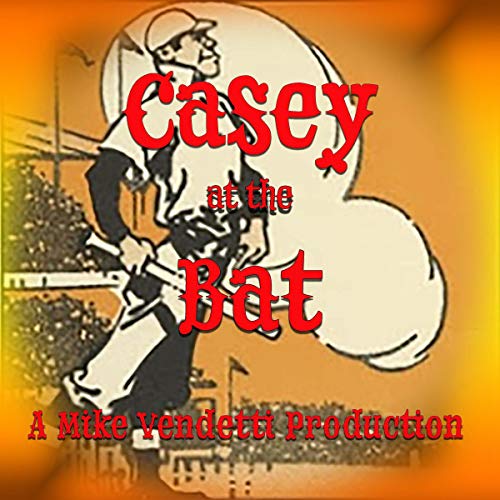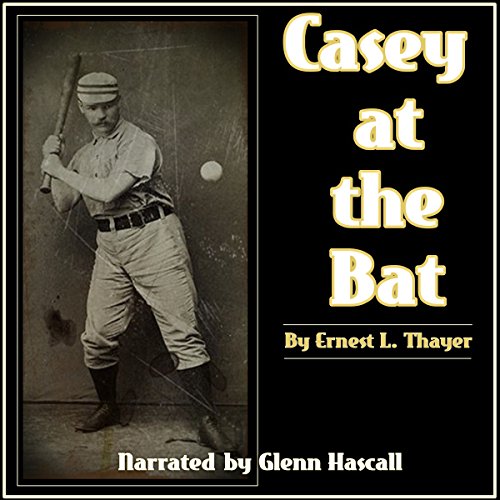-
Casey at the Bat
Ernest Lawrence Thayer, Mike Vendetti, Spoken Realms
Audiobook (Spoken Realms, Jan. 30, 2020)One of the best-known poems in American literature, "Casey at the Bat", written in 1888 by Ernest Thayer and first published in The San Francisco Examiner on June 3, 1888, later popularized by DeWolf Hopper in many vaudeville performances. Read by award-winning narrator Mike Vendetti.
-
Casey at the Bat
Ernest L. Thayer
Paperback (Grosset & Dunlap, Nov. 1, 1988)None
-
Casey at the Bat
Lawrence J Gu Ernest Lawrence Thayer
Paperback (Wentworth Press, Aug. 25, 2016)This work has been selected by scholars as being culturally important, and is part of the knowledge base of civilization as we know it. This work was reproduced from the original artifact, and remains as true to the original work as possible. Therefore, you will see the original copyright references, library stamps (as most of these works have been housed in our most important libraries around the world), and other notations in the work.This work is in the public domain in the United States of America, and possibly other nations. Within the United States, you may freely copy and distribute this work, as no entity (individual or corporate) has a copyright on the body of the work.As a reproduction of a historical artifact, this work may contain missing or blurred pages, poor pictures, errant marks, etc. Scholars believe, and we concur, that this work is important enough to be preserved, reproduced, and made generally available to the public. We appreciate your support of the preservation process, and thank you for being an important part of keeping this knowledge alive and relevant.
-
Casey at the Bat
Ernest L. Thayer, Glenn Hascall, Spoken Realms
Audiobook (Spoken Realms, Jan. 29, 2014)An epic battle is taking place in Mudville. If the team can just hold on for Casey to get a whack then life will be grand. Such poise, such command, such promise. A classic poem narrated by Glenn Hascall.
-
Casey At The Bat
Ernest Lawrence Thayer
School & Library Binding (Turtleback, Jan. 1, 1739)None
-
Casey at the Bat
Ernest L. Thayer
Paperback (Memoria Pr, Jan. 1, 2020)None
-
Casey at the Bat
Ernest Lawrence Thayer, Barry Moser, Donald Hall
Library Binding (San Val, Jan. 1, 1998)None F
F
-
Casey at the Bat
Ernest L. Thayer
Paperback (Printed for the Friends of Emily Connor, The Marchbanks Press, Aug. 16, 1954)Designed by Joseph Weiler at Marchbanks. 10 pages. Christmas 1954, 12mo., paper wrappers.. the Marchbanks Press.
-
Casey At The Bat
LeRoy Neiman
Hardcover (HarperCollins, Jan. 1, 2000)None
-
Casey at the Bat
Ernest Lawrence THAYER (1863 - 1940)
MP3 CD (IDB Productions, Jan. 1, 2017)Casey at the Bat is also called as A Ballad of the Republic, Sung in the Year 1888. The poem is about playing baseball where two teams compete with each other but in the end, only one team wins. Baseball is a game using a bat and a ball played among two teams of nine players each, who take chances in batting and fielding. The batting team tries to score runs by striking a ball thrown by the pitcher with a bat shifted by the batter, then goes in the opposite direction in a series of four bases. Ernest Lawrence Thayer was a writer and poet who had written the poem Casey or Casey at the Bat, which is "the single most famous baseball poem ever written" as stated in the Baseball Almanac, and "the nation’s best-known piece of comic verse—a ballad that began a native legend as colorful and permanent as that of Johnny Appleseed or Paul Bunyan.” Ernest was born in Lawrence, Massachusetts and grew up near Worcester. He was magna cum laude in philosophy from Harvard University, where he became the editor of the Harvard Lampoon and a member of the theatrical society Hasty Pudding. William Randolph Hearst, a friend from those affairs, employed Thayer as humor columnist for the San Francisco Examiner. It was not until so many months after the print of the poem Casey that he became renowned for it, because he was barely the arrogant kind and had used the pen name Phin which he had used since became a writer for the Harvard Lampoon. Two secrets endure of the poem: whether Casey and Mudville were a true person or place, and, if so, their real profiles. Katie Zezima of The New York Times wrote an article entitled "In 'Casey' Rhubarb, 2 Cities Cry 'Foul!'" on the contrasting statements of two towns to such repute as Stockton, California, and Holliston, Massachusetts.
-
Casey at the Bat
Ernest Lawrence Thayer
Library Binding (Franklin Watts, Incorporated, Jan. 1, 1964)None
-
Casey at the bat
Ernest L. Polacco
Hardcover (Putnam Juvenile, March 15, 1884)None